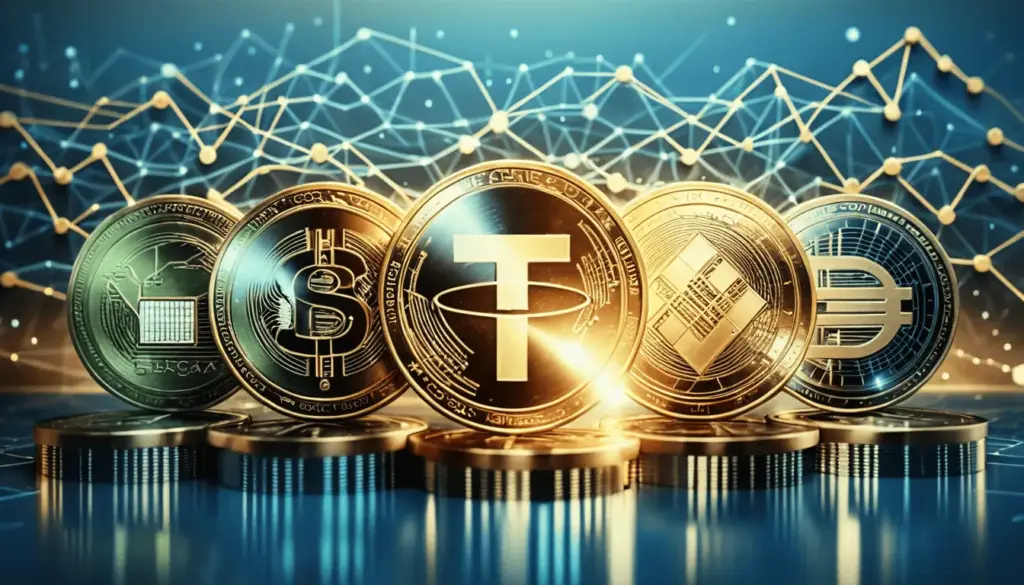The world of blockchain technology and cryptocurrencies has experienced incredible growth in recent years. However, the extreme price swings of major cryptocurrencies like Bitcoin and Ethereum can be unsettling for investors. In the face of this volatility, stablecoins have emerged with a clear purpose: to maintain a stable value.
Designed to have their value pegged to a specific asset, such as fiat currencies, commodities, or even other cryptocurrencies, stablecoins aim to minimize price fluctuations. This stability is making them more than just investment tools; they’re becoming a fundamental part of the digital economy’s infrastructure. In this article, we’ll explore the different types of stablecoins, how they work, their real-world uses, the current market situation, and what the future might hold.

What Exactly Are Stablecoins?
Stablecoins are digital assets designed to maintain a stable price by linking their value (pegging) to a more stable asset like fiat currencies (USD, EUR), commodities (gold, silver), or other assets. Popular examples include Tether (USDT), USD Coin (USDC), and Binance USD (BUSD), all designed to maintain a value of approximately one U.S. dollar. Stablecoins help investors avoid the volatility risks associated with other cryptocurrencies and facilitate easier interaction between the crypto world and the traditional financial system, playing a vital role in the broader adoption of cryptocurrencies.
Understanding the Different Types of Stablecoins and How They Work
Stablecoins achieve price stability through various mechanisms, leading to different classifications:
✅ Fiat-Collateralized Stablecoins
This is the most common type. These stablecoins are backed by reserves of fiat currencies like the U.S. dollar (USD) or the Euro (EUR). For every stablecoin issued, an equivalent amount of the fiat currency is held in reserve. Tether (USDT), USD Coin (USDC), and Binance USD (BUSD) are prime examples. Transparency through regular audits is crucial for these stablecoins to maintain trust in their peg.
✅ Crypto-Collateralized Stablecoins
These stablecoins use other cryptocurrencies, such as Bitcoin or Ethereum, as collateral. To account for the price volatility of these underlying assets, they typically employ over-collateralization, meaning more collateral is held than the value of the issued stablecoins. MakerDAO’s DAI is a well-known example. Their issuance and management are often automated through smart contracts.
✅ Algorithmic Stablecoins
Unlike collateralized stablecoins, algorithmic stablecoins rely on algorithms and smart contracts to maintain their peg. These mechanisms adjust the supply and demand of the stablecoin to keep its price stable. However, they carry the risk of failing to maintain their peg, as demonstrated by the past collapse of Terra USD (UST).
✅ Commodity-Collateralized Stablecoins
These stablecoins are backed by physical assets like gold, silver, or oil. Linking their value to tangible assets can offer relative price stability. However, the storage and auditing of these physical reserves can be complex.
Key Roles and Use Cases of Stablecoins
Stablecoins are playing increasingly important roles in various sectors, driving the growth of the digital economy:
✅ Store of Value and Payment Method
Due to their lower volatility, stablecoins are more suitable for storing value and making payments compared to traditional cryptocurrencies. They provide a crucial tool for cryptocurrency investors looking to reduce exposure to price swings and facilitate efficient transactions.
✅ Core Component of the Decentralized Finance (DeFi) Ecosystem
Stablecoins are widely used in Decentralized Finance (DeFi) for activities like collateralized lending, providing liquidity to decentralized exchanges, and staking. For instance, users can borrow funds by providing stablecoins as collateral or earn interest by supplying stablecoins to liquidity pools.
✅ Revolutionizing International Remittances and Payments
Stablecoins offer a potential solution to the high fees and long processing times associated with traditional international money transfers. They enable faster and cheaper cross-border payments, particularly beneficial in countries with less robust financial systems where stablecoins can serve as a reliable medium of exchange.
✅ Bridging the Gap with Traditional Finance
Stablecoins act as a bridge between the cryptocurrency market and traditional financial markets. Many cryptocurrency exchanges use stablecoins as a substitute for fiat currencies, and institutional investors are increasingly exploring asset management strategies involving stablecoins.
Current Stablecoin Market Overview and Trends
The stablecoin market has shown consistent growth, reaching a total market capitalization exceeding $200 billion USD by the end of 2024, marking an all-time high. Trading volumes have also been steadily increasing. Fiat-collateralized stablecoins dominate the market, with USDC and USDT holding the largest market shares.
Key recent trends in the stablecoin market include:
✅ Increased Institutional Investment
As institutional investors enter the digital asset space, the demand for stablecoins is also rising. Institutions utilize stablecoins for efficient capital management and trading activities.
✅ Growing Regulatory Scrutiny
Governments and regulatory bodies worldwide are expressing concerns about the potential risks associated with stablecoins (such as money laundering and consumer protection) and are moving towards stricter regulations. The European Union’s MiCA (Markets in Crypto-Assets) regulation, for example, is establishing a clear regulatory framework for the issuance and operation of stablecoins.
✅ Central Bank Digital Currency (CBDC) Research
Central banks in various countries are actively researching the possibility of issuing their own digital currencies. This could have a direct or indirect impact on the stablecoin market, potentially leading to competition or a complementary relationship between CBDCs and stablecoins.
✅ Emergence of New Types of Stablecoins
Beyond traditional fiat-backed stablecoins, new approaches are emerging, such as stablecoins backed by tokenized Real World Assets (RWAs). This is expected to broaden the potential applications of stablecoins.
The Future Outlook for Stablecoins
The future of stablecoins looks promising, with several key trends shaping their trajectory:
✅ Increased Regulation and Mainstream Adoption
Governments and financial regulators globally are working on establishing legal frameworks and issuance standards for stablecoins, indicating increased regulation is on the horizon. Major countries like the United States, the European Union, and South Korea are developing policies aimed at enhancing the transparency and consumer protection of stablecoins.
✅ Competition with Central Bank Digital Currencies (CBDCs)
The introduction of CBDCs could potentially reshape the role of stablecoins. If CBDCs become strongly integrated with existing financial systems, privately issued stablecoins might face increased competition.
✅ Expanding Role in the Global Financial System
Stablecoins have the potential to become a crucial component of international payments and financial services. Their use as digital currencies in countries with limited access to traditional banking is likely to grow, and they are also expected to see increased adoption in global trade and business-to-business (B2B) transactions.
✅ Diversification of Stablecoin Types
In the future, we can expect to see new types of stablecoins backed by a wider range of assets beyond fiat currencies, such as gold, real estate, and commodities. This will offer investors more diverse options.
In Conclusion
Stablecoins play a vital role in the growth of the digital economy by mitigating the volatility of the cryptocurrency market and acting as a bridge to the traditional financial system. As a core asset in the Decentralized Finance (DeFi) ecosystem, they are driving the development of innovative financial services and contributing to the creation of borderless payment systems.
The stablecoin market is projected to grow further, fueled by increasing institutional investment, regulatory clarity, and technological advancements. More than just a “safe haven” asset, stablecoins have the potential to become a crucial pillar of the future financial system. It will be fascinating to observe the innovative changes they bring, and continued attention and careful consideration are warranted. Thank you for reading.


